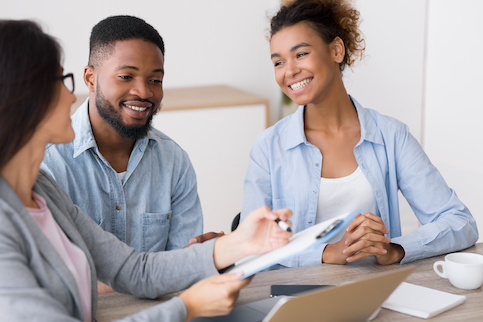If you’ve bought or sold real estate, you’ve probably heard of commercial mortgage-backed securities, or CMBS. A CMBS loan is a fixed-income investment backed by commercial real estate properties.
CMBS loans offer many advantages for both the borrowers and the investors involved in this process. As a borrower, you could earn low fixed-rate terms and gain access to high-leverage financing for investment properties.
But how do you take out a CMBS loan? And what are the advantages and disadvantages of choosing one over a traditional commercial loan? These are the exact questions this article will set out to answer.
What Is A CMBS Loan?
Commercial mortgage-backed securities are a bundle of commercial real estate loans sold by the lender as a series of bonds. CMBS loans, also called conduit loans, are often used to buy commercial real estate property types such as apartment complexes, multifamily homes, retail buildings or office centers.
When a lender issues a CMBS loan, they pool it with a number of similar loans. These are then divided into tranches, depending on the level of risk involved. The highest-rated tranches have the least amount of risk, so these loans will be paid in full first. Low-rated tranches come with higher credit risk, so they’re the first to absorb any losses when a borrower defaults on the loan.
What Is Securitization?
The process of bundling CMBS loans together and selling them to investors is known as securitization. Most lenders perform between three to eight securitizations a year. But this depends on the lender’s size and the loans being issued.
Overall, the securitization process benefits both the lender and the investors involved. It makes it possible for banks to issue more loans and gives investors early access to commercial real estate.
See What You Qualify For
Buy A Home
Discover mortgage options that fit your unique financial needs.

Refinance
Refinance your mortgage to have more money for what matters.
Tap Into Equity
Use your home’s equity and unlock cash to achieve your goals.
How Do CMBS Loans Work?
When a borrower closes on a property, the mortgage is initially funded by the financial institution issuing the loan. Multiple CMBS loans are then packaged in the form of bonds and are typically held within a trust.
The loans are diversified by the loan terms, amount and property type. The bonds are also rated based on the average loan amount, debt-to-income ratio (DTI) and the number of loans in the pool. After the bonds are rated, they’re sold to investors. Once the CMBS loan is sold, the original lender is repaid. This gives the bank more liquidity to continue issuing loans.
Pros Of CMBS Loans
If you’ve been looking into purchasing an investment property, then CMBS loans aren’t a bad place to start. Let’s look at some of the advantages of choosing a CMBS loan.
Fixed Interest Rates
These loans tend to come with better interest rates than you’d find with a traditional commercial loan. CMBS loans typically come with fixed interest rates, which means the rates won’t fluctuate throughout the life of the loan.
These types of loans tend to be a better bet for both the borrowers and the investors. Borrowers get to take advantage of consistent monthly payments. These types of loans have a lower risk of default than variable rate loans.
High Leverage
CMBS loans tend to come with high-leverage financing but don’t have the same high requirements for a borrower’s credit or net worth. Most properties come with a 75% maximum loan-to-value (LTV) ratio.
Nonrecourse Terms
CMBS loans are also considered nonrecourse loans. This means if the borrower fails to repay the debt, the lender can’t pursue legal action to hold the borrower accountable for the loan’s full amount.
This is an obvious win for borrowers, but there are a few caveats. Most CMBS loans have fine print that outlines specific conditions under which the loan would become full recourse.
For instance, most loan terms state that if a borrower commits fraud or misrepresents their financial situation during the application process, the loan becomes full recourse. You’d also be held liable if you caused intentional damage to the property.
Loan Assumption
Most CMBS loans are assumable, though a small fee may be required. This means if you want to sell commercial real estate and someone is willing to take on the loan, you can hand it off to them.
That borrower will then be bound to the same terms of the original loan agreement. An assumable loan is a significant advantage for borrowers, especially since most CMBS loans don’t allow for prepayments.
Ready to Find Out What You Qualify For?
See options that work for your unique financial situation.
Cons Of CMBS Loans
While there are quite a few upsides to CMBS loans, there are certain disadvantages to this decision. Let’s look at some of the biggest pitfalls of CMBS loans.
Prepayment Penalties
CMBS loans come with prepayment penalties, which means borrowers can be penalized for paying off the loan early. These penalties allow investors to earn the same type of profit as if they paid the loan off in the agreed-upon time frame.
There are two different types of prepayment penalties associated with CMBS loans: yield maintenance and defeasance. In the event of a yield maintenance penalty, the borrower must pay a fee between 1% – 3% of the entire loan amount. We’ll look at the defeasance requirements more closely in the next section.
Defeasance Requirements
Some CMBS loans are required to go through a process called defeasance before they can be prepaid. Defeasance is a condition or clause that can render a contract or deed null and void. This involves a borrower purchasing alternative securities to replace the collateral and interest the lender will lose out on.
Defeasance can be a complex process, and the terms should be outlined in the original loan agreement. Borrowers will likely need to work with an experienced financial advisor to ensure the process is carried out correctly.
Financing Restrictions
One of the biggest disadvantages of a CMBS loan is the lack of flexibility in negotiating loan terms. The interests of the investors always come first, so borrowers have little say about the terms involved. And once the loan documents have been signed, there are even fewer opportunities to make changes.
How To Take Out A CMBS Loan
Let’s walk through the process of taking out a CMBS loan.
1. Meet CMBS Loan Requirements
To qualify for a CMBS loan, most lenders require a net worth equal to at least 25% of the total loan amount. And at least 5% of the total loan amount must be available in liquid assets.
2. Decide On The Loan Term
The terms on a CMBS loan are typically available in 5, 7 or 10 years with an amortization of 25 – 30 years. Since the terms don’t match the amortization schedule, the loan balloons at the end of the term. At that point, the remaining amount must either be paid in full or refinanced.
3. Work With A Master Servicer
Once you’ve gone through closing, you won’t be dealing with your initial lender any longer. Instead, you’ll begin working with a master servicer.
A master servicer is a company that specializes in administering conduit loans. The master servicer will collect your payments, inspect the property and take care of other administrative tasks.
FAQ
CMBS loans are more complex than traditional mortgages, so it’s important to ask questions. If you’re considering a CMBS loan, use these questions to help you better understand this lending tool.
The Bottom Line
A CMBS loan is a bond that’s made up of a group of underlying commercial mortgages. These bonds pay investors a return based on the principal and interest payments made by borrowers.
If you’re considering investing in commercial real estate, then a CMBS loan could be a good option for you. But just like any other type of financing, you should make sure you consider all of your options first.
For many people, CMBS loans may not offer the most favorable terms and rates. And even if you do find favorable rates, the servicer will structure the loan in a way that benefits the investors.
See What You Qualify For
You can get a real, customizable mortgage solution based on your unique financial situation.

Victoria Araj
Victoria Araj is a Staff Writer for Rocket Companies who has held roles in mortgage banking, public relations and more in her 15-plus years of experience. She has a bachelor’s degree in journalism with an emphasis in political science from Michigan State University, and a master’s degree in public administration from the University of Michigan.












